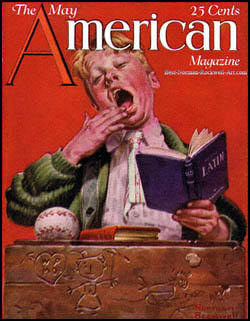The American Magazine
In 1906 several journalists working for McClure's Magazine, including Lincoln Steffens, Ray Stannard Baker, Ida Tarbell and William A. White left and established the American Magazine. It soon established itself as one of America's leading investigative magazines. However, its opponents accused the magazine of muckraking journalism.
Some of the journalists who contributed to The American Magazine included Ray Stannard Baker (The Colour Line in the North, February 1908; The Negro's Struggle for Survival, in the North, March, 1908, Lift Man From the Gutter? Or Remove the Gutter? Which?, July, 1909); Upton Sinclair (The Metropolis, January, 1908), Lincoln Steffens, (Hearst, the Man of Mystery, November, 1906) and Ida Tarbell (John D. Rockefeller: A Character Sketch, July, 1907; Roosevelt vs. Rockefeller, December, 1908); The Mysteries and Cruelties of the Tariff, November, 1910; The Hunt for the Money Trust, May, 1913).

Other contributors to the American Magazine included Sherwood Anderson, Neith Boyce, Frances Hodgson Burnett, Arthur Conan Doyle, Will Durant, F. Scott Fitzgerald, Graham Greene, Dashiell Hammett, Walter Lippmann and H.G. Wells.
The American Magazine ceased publication in August 1956.
Primary Sources
(1) Ray Stannard Baker, The American Magazine (1908)
One of the points in which I was especially interested was the Jim Crow regulations, that is, the system of separation of the races in street cars and railroad trains.
I was curious to see how the system worked out in Atlanta. Over the door of each car, I found the sign: "White people will seat from front of car toward the back and colored people from toward front". Sure enough, I found the white people in front and the Negroes behind.
As the sign indicates, there is no definite line of division between the white seats and the black seats, as in many other Southern cities. This very absence of a clear demarcation is significant of many relationships in the South. The colour line is drawn, but neither race knows just where it is. Indeed, it can hardly be definitely drawn in many relationships, because it is constantly changing. This uncertainty is a fertile source of friction and bitterness.
The very first time I was on a car in Atlanta, I saw the conductor - all conductors are white - ask a Negro woman to get up and take a seat farther back in order to make a place for a white man. I have also seen white men requested to leave the Negro section of the car.
"We pay first-class fare," said one of the leading Negroes in Atlanta, "exactly as the white man does, but we don't get first-class service. I say it isn't fair."
Charles T. Hopkins, a leader in the Civic League and one of the prominent lawyers of the city, told me that he believed the Negroes should be given their definite seats in every car; he said that he personally made it a practice to stand up rather than to take any one of the four back seats, which he considered as belonging to the Negroes.
(2) Ray Stannard Baker, The American Magazine (1908)
A few years ago no hotel or restaurant in Boston refused Negro guests; now several hotels, restaurants, and especially confectionary stores, will not serve Negroes, even the best of them. The discrimination is not made openly, but a Negro who goes to such places is informed that there are no accommodations, or he is overlooked and otherwise slighted, so that he does not come again. A strong prejudice exists against renting flats and houses in many white neighbourhoods to coloured people. The Negro in Boston, as in other cities, is building up "quarters," which he occupies to the increasing exclusion of other classes of people.
